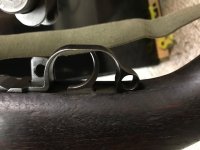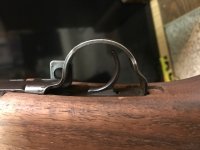As far as I know the only reason for the bolt knob was to either cock or decock the weapon.
You're right, that's pretty much all you can do with it.

Several others such as the krag, arisaka, and enfield had enhanced grabbing bolt heads.
I know what you are talking about, but some others might not, so a small point of clarification about the usual use of terms is in order.
"Bolt knob" is usually used referring to the knob on the end of the bolt handle, and "bolt head" is commonly used referring to the front of the bolt, where many (but not all) designs put the locking lugs.
What we are talking about is the rear end of the firing pin assembly, which is usually called the "cocking piece".
The design of the cocking piece on the different military bolt guns shows either the intent of the designers, or the requirements of the purchasers. One thing to keep in mind is that the designs all pre-date 1900 or are based largely on designs that pre-date 1900. An era when misfires, hangfires and ruptured cases/primers were much, much more common than today.
I believe the intent of an easily grabbed cocking piece knob was so that the event of a misfire (dud) weapon could be recocked without operating the bolt. A "second strike" capability. And, it could also be used to decock the EMPTY rifle without dry firing it.
I don't think any military would have had troops lowering the firing pin (decocking) with a live round in the chamber. In all the designs I'm aware of, that would put the firing pin in contact with the primer, which is not even remotely a safe way to carry the rifle, as any blow to the back of the firing pin would go straight to the primer, firing the round.
The British Enfield (SMLE) has an "enhanced grabbing" cocking piece, its large, flat, and grooved for that reason, and is a carryover from the original Enfield design, which dates from 1888.
The large knob at the rear of the Arisaka bolt is the safety. It is operated by pushing in and turning it, to put the safety "on". Pulling on that knob will not cock the rifle.
The Moisin Nagant has a large knob at the back, which is also the safety, but can be used to cock or decock the rifle.
The Mauser 98 doesn't have a cocking piece knob, though there are a pair of slots in the cocking piece where a makeshift tool could be "hooked" to pull the cocking piece back, without working the bolt.
The Krag has a cocking piece knob, allowing for an easy "second strike" on a primer. The 1903 Springfield has that same knob, and I believe that it was carried over from the Krag to the Springfield at the request of the Army. (just my theory, I have no proof).
I think it is a reasonable theory, because of the second feature shared by the Krag and the Springfield, the magazine cut-off. I think both these features, found on the Krag were carried over to the Springfield because the Army wanted them (at the time). Note that later (newer) designs don't have either of them. The US 1917 Enfield comes to mind. Neither a cocking piece knob or a magazine cutoff on that design. I think that after the 1903 design, it was finally recognized that neither feature was really needed, and was simply extra manufacturing expense for something that wasn't very useful.
As far as I know, the US was the only nation to use the magazine cutoff, and we dropped it after the 1903 Springfield design. The idea sounds useful, allowing the solider to single load rounds for aimed fire, while keeping the loaded magazine in reserve, available at the flip of a switch for "emergencies" but in practice turned out to be of little or no practical value.
Here's a little known tidbit, showing how some ideas carry on, even when they have already been largely discarded. The "second strike" capability (recocking the gun for a second strike on the primer, without working the action) can also be done with the M1 Garand and the M14 rifle! Even the M16 can be "recocked" without moving the bolt, though doing it is more awkward than doing it with the other rifles named.
The 1903 Springfield is a hybrid of Krag and Mauser features, enough Mauser that a court eventually ruled that we had to pay Mauser royalties on our use of their design. And, we did, though Mauser never got a penny of them, we did pay...
(the payments were held in escrow due to WW I, and after the war, seized as part of Germany's "reparation payments". Neither the German government nor Mauser ever got any of the money.)



